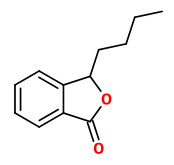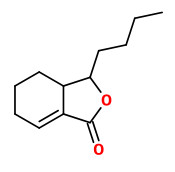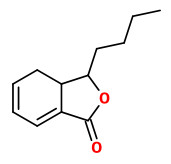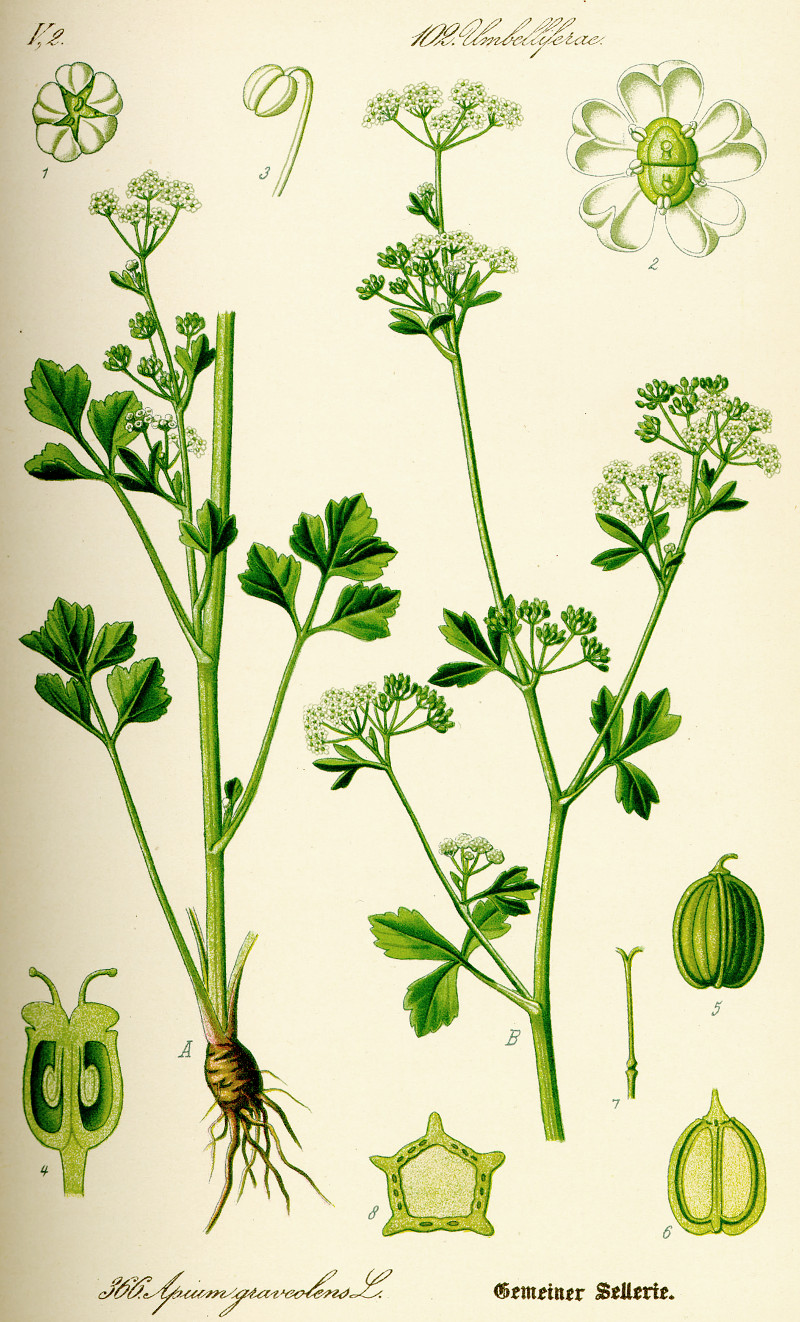Apium graveolens L. - syn.Apium celleri Gaertner; Apium maritimum Salisb.; Celeri graveolens Britton; Sium apium Roth; Sium graveolens Vest - Apiaceae
celery, celeriac, wild Celery, Sellerie, Echte Sellerie, Gemeiner Eppich
Taprooted, strong smelling glabrous biennial, 0.30-1m high, native to Europe, naturalized in North America, cultivated worldwide; leaves once pinnate, leaflets 3-9, broadly triangular to suborbicular, usually deely 3-lobed into cuneate-obovate, serrate or incised segments; umbels sessile or short-peduncled; flowers white, very small, June-Sept., the small compound umbels among the leaves, one sessile and one several long-stemmed, naked or leafy-bracteate umbels springing from the same joint.
The original wild growing Apium graveolens ssp. graveolens (wild celery, smallage) has a thin, branched and bitter tasting taproot, leaves are short petioled.
„In Central Europe the wild form is found exclusively on moist to wet, nutrient-rich, salty mud floors.“
http://de.wikipedia.org/wiki/Echter_Sellerie
Three cultivars are known:
Apium graveolens L. var.rapaceum (Mill.) Gaud.-Beaup. - celeriac, Knollen-Sellerie, with a bulbous root, and
Apium graveolens L. var.dulce Mill. - (self-blanching) celery, Stangensellerie, with fleshy petioled leaves.
Apium graveolens L. var. secalinum Alef. - Chinese celery, Schnittsellerie, with thin stems and leaves that are used as much as the stalks for soups etc.
„The characteristic odor of celery essential oil is due to a series of phtalide derivatives, of which 3-n-butylphthalide and sedanolide are reported to be the major odor components.“
[Phthalide components of celery essential oil., Bjeldanes, L.F., Kim, I.S., The Journal of Organic Chemistry, 42(13), 1977, 2333-2335]
 3-n-butyl phtalide |  sedanolide |  sedanenolide |
„The aroma volatiles of a local variety of celery from Libya were analysed using routine procedures… Unusually, three constituents alone made up ca 70% of the total volatiles, 4,7-dimethoxy-5-(prop-2-enyl)benzo-1,3-dioxolan or apiole (ca 23%), 3-butylphthalide (ca 22%) and 3-butyltetrahydrophthalide or sedanolide (ca 24%). The latter two compounds are known to possess strong characteristic celery aroma.“
[Volatile aroma constituents of celery. MacLeod, A. J., MacLeod, G., Subramanian, G., Phytochemistry, 27(2), 1988, 373-375]
The essential oil of celery and celeriac, extracted by simultaneous steam distillation-extraction, is dominated by terpenes (28-63mg/kg), with limonene as main constituent (12-37mg/kg), followed by γ-terpinene. Other characteristic compounds present are pyridine, hexanal, furfural, 3-methyl-4-ethyl hexane, and phtalides (2-7mg/kg; 3-n-butylphthalide, neocnidilide = sedanolide, senkyunolide).
[Aromatic volatile composition of celery and celeriac cultivars. Van Wassenhove, F., Dirinck, P., Vulsteke, G., Schamp, N., HortScience, Vol.25(5), 1990, 556-559] http://hortsci.ashspublications.org/content/25/5/556.full.pdf
Limonene (50.9%), β-selinene (19.53%), 3-n-butylphthalide (6.92%) nerolidol (2.29%), α-selinene (1.63%), β-pinene (1.22%), d-carvone (1.86%), n-amylbenzene (1.63%), β-myrcene (1.3%) and cis-limonene oxide (1.12%) were the major constituents of Apium graveolens L. seed volatile oil.
[Studies on chemical and technological aspects of celery (Apium graveolens. Linn) seed., Rao, L.J.M., Nagalakshmi, S., Naik, J.P., Shankaracharya, N.B., Journal of Food Science and Technology (Mysore), 37(6), 2000, 631-635]
„The raw and boiled odors of celery leaves and stalks were investigated. Among 12 compounds identified as potent odorants, 3-n-butylphthalide, sedanenolide, and trans- and cis-sedanolides were assessed to be most contributive to the overall odor of celery. These three phthalides, (3E,5Z)-1,3,5-undecatriene, myrcene, and (E)-2-nonenal were common to both raw and boiled materials. Two compounds, ((Z)-3-hexenal and (Z)-3-hexenol), were dominant in raw materials and four compounds, (2-methylbutanoic acid, sotolon, β-damascenone, and β-ionone), were dominant in boiled materials. Sensory evaluations were performed on natural celery odor and a series of reconstructed model aromas by assigning each intensity ratings for a set of seven odor qualities which aptly describe the odors of raw and boiled celery. According to the evaluation results, six common components contributed to the moderate odor of raw celery, two components dominant in raw materials enhanced the raw celery character, and four components dominant in boiled materials reduced the raw celery character and enhanced the boiled celery character. It was clarified that boiling-induced changes in celery odor were not affected by the amounts of phthalides, but by thermally generated compounds such as sotolon, β-damascenone, and β-ionone, which reduce the “green spicy” note.“
[Potent odorants characterize the aroma quality of leaves and stalks in raw and boiled celery. Kurobayashi, Y., Kouno, E., Fujita, A., Morimitsu, Y., Kubota, K., Bioscience, biotechnology, and biochemistry, Vol.70(4), 2006, 958-965]
„This study investigates the antiulcerogenic and antibacterial activities of Apium graveolens extracts. The antiulcerogenic activity was evaluated in rats by the HCl/EtOH method. Inhibition of gastric lesions by A. graveolens extracts was dose-dependent for both aerial part (53–76%) and seeds (51–95%). The methanolic extract as well as the aqueous extracts used at 300 mg kg−1 dose exhibited a highly significant inhibition of gastric lesions (91% and 95%, respectively) which was similar to that induced by omeprazole (94%). Essential oil and aqueous extract prepared from the aerial parts of A. graveolens were tested to determine their antibacterial activity using the paper disc-diffusion method, the minimal inhibitory concentration and the minimal bactericidal concentration. Essential oil of A. graveolens was strongly inhibitory against Escherichia coli and moderately inhibitory against Pseudomonas aeruginosa and Staphylococcus aureus. The chemical composition of the volatile oil was investigated by gas chromatography analysis. The major components identified were β-pinene, camphene, cumene, limonene, α-thujene, α-pinene, β-phellendrene, p-cymene, γ-terpinene, sabinene and terpinolene.“
[Antiulcerogenic and antibacterial activities of Apium graveolens essential oil and extract. Baananou, S., Bouftira, I., Mahmoud, A., Boukef, K., Marongiu, B., Boughattas, N. A., Natural product research, Vol.27(12), 2013, 1075-1083]

Thomé,O.W., Flora von Deutschland Österreich und der Schweiz, Tafeln, vol.3, t.366 (1885)
http://plantgenera.org/species.php?id_species=74940